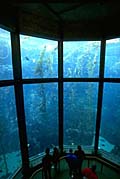
The Association of Zoos and Aquariums (AZA) in the US has announced its top 10 wildlife conservation success stories for 2007. From amphibians to zebras, AZA-accredited zoos and aquariums are spearheading new efforts to protect wild animals — in some cases bringing them back from the brink of extinction.
“AZA-accredited zoos and aquariums are leaders in wildlife conservation and education,” said AZA President and CEO Jim Maddy. “This Top 10 list is just a small sample of the important work of AZA-accredited zoos and aquariums.”
In the last five years, AZA-accredited facilities funded 3,693 conservation projects in more than 100 countries. Annual spending on conservation averages nearly $70 million per year.
Three marine-based projects were included in the Top 10 Wildlife Conservation Success Stories in 2007 :-
The right stuff for right whales
The world’s rarest large whale, the right whale, has been the topic of interest for scientists at the New England Aquarium this past year. Fewer than 350 North Atlantic right whales currently exist in the world, and are threatened by ship collisions and entanglement in fishing gear, habitat loss, pollution, and disease.
The New England Aquarium’s Right Whale Research Project recently developed a test to learn more about the reproductive rates of the endangered species. This information is critical in helping these giant sea creatures survive.
International sea turtle success
The Kemp’s ridley sea turtle population is in bad shape, but thanks to cooperation between U.S and Mexican officials and scientists, the species can rest assured that their nesting sites will be safe.
The Gladys Porter Zoo in Brownsville, Texas, and Mexican conservation workers have protected the turtle’s nesting sites on beaches in Tamaulipas, Mexico and Padre Island National Seashore. The Zoo reports an increase in nests by the hundreds each year on the Mexican Gulf Coast, indicating success of the program.
Saving “Jaws”
For the third time since 2004, the Monterey Bay Aquarium has placed a young white shark on public exhibit.
The shark was caught accidentally in commercial fishing gear off Southern California.
Through its White Shark Research Project, the Aquarium has worked since 2002 to learn more about white sharks in the wild, and has since tagged and tracked 10 juvenile white sharks off Southern California. White sharks are in decline worldwide, in part because they are slow to reproduce and also because of growing fishing pressure that is decimating all shark species.
Their fearsome reputation has also made them a target of trophy hunters and the curio trade. The Aquarium’s hope in exhibiting a white shark is to change public attitudes and promote greater protection for these much maligned ocean predators.
Source: AZA Press Release











Social Profiles